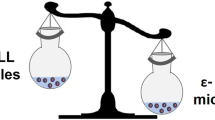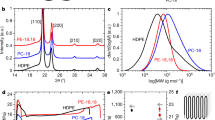Abstract
This study investigated fully bio-based blends of trans-1,4-polyisoprene from Eucommia ulmoides Oliver (EuTPI) and linear poly(ricinoleic acid) (LPRA) or tri-branched poly(ricinoleic acid) (BPRA). LPRA and BPRA were synthesized using an immobilized lipase as the catalyst. Blends of EuTPI with LPRA or BPRA in various mixing ratios were examined. Scanning electron microscope observations suggest that BPRA was uniformly distributed in the EuTPI matrix in contrast to the poor distribution of LPRA, and BPRA was effectively incorporated into the crosslinked network of EuTPI by curing with dicumyl peroxide. Rheological studies indicate that BPRA was more effective than LPRA at improving the processability of EuTPI. The storage modulus, loss modulus and complex viscosity (η) of EuTPI over a frequency (ω) range from 0.1 to 100 rad s−1 at 80 °C clearly decreased with an increase in BPRA content. At low frequency, the rheological behavior of EuTPI changed from that of an elastic gel to that of a liquid when 15 wt% of BPRA was added. Moreover, η dramatically decreased to ~5% of that of the pure EuTPI at ω=0.1 rad s−1. Thermogravimetric analysis results suggest that the blending of BPRA would not compromise the thermal stability of EuTPI. BPRA was found to promote the formation of more stable α-phase crystallites in EuTPI by differential scanning calorimetry analysis.
Similar content being viewed by others
Log in or create a free account to read this content
Gain free access to this article, as well as selected content from this journal and more on nature.com
or
References
Kent, E. G. & Swinney, F. B. Properties and applications of trans-1,4-polyisoprene. Ind. Eng. Chem. Prod. Res. Dev. 5, 134–138 (1966).
Goodman, A., Schilder, H. & Aldrich, W. The thermomechanical properties of gutta-percha: II. The history and molecular chemistry of gutta-percha. Oral. Surg. Oral. Med. Oral. Pathol. 37, 954–961 (1974).
Nakazawa, Y., Takeda, T., Suzuki, N., Hayashi, T., Harada, Y., Bamba, T. & Kobayashi, A. Histochemical study of trans-polyisoprene accumulation by spectral confocal laser scanning microscopy and a specific dye showing fluorescence solvatochromism in the rubber-producing plant, E. ulmoides Oliver. Planta 238, 549–560 (2013).
Tangpakdee, J., Tanaka, Y., Shiba, K., Kawahara, S., Sakurai, K. & Suzuki, Y. Structure and biosynthesis of trans-polyisoprene from Eucommia ulmoides. Phytochemistry 45, 75–80 (1997).
Nakazawa, Y., Bamba, T., Takeda, T., Uefuji, H., Harada, Y., Li, X., Chen, R., Inoue, S., Tutumi, M., Shimizu, T., Su, Y., Gyokusen, K., Fukusaki, E. & Kobayashi, A. Production of Eucommia-rubber from Eucommia ulmoides Oliv. (Hardy Rubber Tree). Plant Biotechnol. 26, 71–79 (2009).
Bamba, T., Fukusaki, E., Nakazawa, Y. & Kobayashi, A. In-situ chemical analyses of trans-polyisoprene by histochemical staining and Fourier transform infrared microspectroscopy in a rubber-producing plant, Eucommia ulmoides Oliver. Planta 215, 934–939 (2002).
Arvanitoyannis, I., Kolokuris, I., Nakayama, A. & Aiba, S. Preparation and study of novel biodegradable blends based on gelatinized starch and 1,4-trans-polyisoprene (gutta percha) for food packaging or biomedical applications. Carbohydr. Polym. 34, 291–302 (1997).
Tsujimoto, T., Toshimitsu, K., Uyama, H., Takeno, S. & Nakazawa, Y. Maleated trans-1,4-polyisoprene from Eucommia ulmoides Oliver with dynamic network structure and its shape memory property. Polymer 55, 6488–6493 (2014).
Zhang, J. & Xue, Z. A comparative study on the properties of Eucommia ulmoides gum and synthetic trans-1,4-polyisoprene. Polym. Test. 30, 753–759 (2011).
Xue, Z., Zhang, J., Li, X. & Yan, R. Damping properties of Eucommia ulmoides gum and its blends. Int. Symp. Eucommia ulmoides 1, 116–118 (2007).
Yan, R. Insight into materials engineering of Eucommia ulmoides gum. Int. Symp. Eucommia ulmoides 1, 34–37 (2007).
Sarina, Zhang, J. & Zhang, L. Dynamic mechanical properties of Eucommia ulmoides gum with different degree of cross-linking. Polym. Bull. 68, 2021–2032 (2012).
Ogunniyi, D. S. Castor oil: A vital industrial raw material. Bioresour. Technol. 97, 1086–1091 (2006).
Mutlu, H. & Meier, M. A. R. Castor oil as a renewable resource for the chemical industry. Eur. J. Lipid Sci. Technol. 112, 10–30 (2010).
Lebarbe, T., Ibarboure, E., Gadenne, B., Alfos, C. & Cramail, H. Fully bio-based poly(l-lactide)-b-poly(ricinoleic acid)-b-poly(l-lactide) triblock copolyesters: investigation of solid-state morphology and thermo-mechanical properties. Polym. Chem. 4, 3357–3369 (2013).
Robertson, M. L., Paxton, J. M. & Hillmyer, M. A. Tough blends of polylactide and castor oil. ACS Appl. Mater. Interfaces 3, 3402–3410 (2011).
Gautrot, J. E. & Zhu, X. X. High molecular weight bile acid and ricinoleic acid-based copolyesters via entropy-driven ring-opening metathesis polymerisation. Chem. Commun. 0, 1674–1676 (2008).
Ebata, H., Yasuda, M., Toshima, K. & Matsumura, S. Poly (ricinoleic acid) based novel thermosetting elastomer. J. Oleo Sci. 57, 315–320 (2008).
Ebata, H., Toshima, K. & Matsumura, S. Lipase-catalyzed synthesis and curing of high-molecular-weight polyricinoleate. Macromol. Biosci. 7, 798–803 (2007).
Shikanov, A. & Domb, A. J. Poly(sebacic acid-co-ricinoleic acid) biodegradable injectable in situ gelling polymer. Biomacromolecules 7, 288–296 (2006).
Kelly, A. R. & Hayes, D. G. Lipase-catalyzed synthesis of polyhydric alcohol-poly(ricinoleic acid) ester star polymers. J. Appl. Polym. Sci. 101, 1646–1656 (2006).
Slivniak, R., Langer, R. & Domb, A. J. Lactic and ricinoleic acid based copolyesters stereocomplexation. Macromolecules 38, 5634–5639 (2005).
Slivniak, R. & Domb, A. J. Macrolactones and polyesters from ricinoleic acid. Biomacromolecules 6, 1679–1688 (2005).
Bódalo-Santoyo, A., Bastida-Rodríguez, J., Máximo-Martín, M. F., Montiel-Morte, M. C. & Murcia-Almagro, M. D. Enzymatic biosynthesis of ricinoleic acid estolides. Biochem. Eng. J. 26, 155–158 (2005).
Teomim, D., Nyska, A. & Domb, A. J. Ricinoleic acid-based biopolymers. J. Biomed. Mater. Res. 45, 258–267 (1999).
Krasko, M. Y., Shikanov, A., Ezra, A. & Domb, A. J. Poly(ester anhydride)s prepared by the insertion of ricinoleic acid into poly(sebacic acid). J. Polym. Sci. A Polym. Chem. 41, 1059–1069 (2003).
Jannerfeldt, G., Boogh, L. & Manson, J. A. E. The morphology of hyperbranched polymer compatibilized polypropylene/polyamide 6 blends. Polym. Eng. Sci. 41, 293–300 (2001).
Chang, K., Robertson, M. L. & Hillmyer, M. A. Phase inversion in polylactide/soybean oil blends compatibilized by poly(isoprene-b-lactide) block copolymers. ASC Appl. Mater. Interfaces 1, 2390–2399 (2009).
Anandakumaran, K., Kuo, C. C., Mukherji, S. & Woodward, A. E. Crystallization of trans-1,4-polyisoprene. J. Polym. Sci. Polym. Phys. 20, 1669–1676 (1982).
Cooper, W. & Vaughan, G. Crystallization of gutta percha and synthetic trans-1,4-Polyisoprenes. Polymer 4, 329–340 (1963).
Pathak, A., Saxena, V., Tandon, P. & Gupta, V. D. Vibrational dynamics of trans-1,4-polyisoprene (β-form). Polymer 47, 5154–5160 (2006).
Acknowledgements
B-xZ thanks the China Scholarship Council (CSC) for a scholarship. This study was partly supported by the Science and Technology Research Promotion Program for Agriculture, Forestry, Fisheries and Food Industry from the Ministry of Agriculture, Forestry and Fisheries of Japan.
Author information
Authors and Affiliations
Corresponding author
Ethics declarations
Competing interests
The authors declare no conflict of interest.
Additional information
Supplementary Information accompanies the paper on Polymer Journal website
Rights and permissions
About this article
Cite this article
Zhang, Bx., Azuma, Ji., Takeno, S. et al. Improvement of the rheological properties of trans-1,4-polyisoprene from Eucommia ulmoides Oliver by tri-branched poly(ricinoleic acid). Polym J 48, 821–827 (2016). https://doi.org/10.1038/pj.2016.30
Received:
Revised:
Accepted:
Published:
Issue date:
DOI: https://doi.org/10.1038/pj.2016.30



